原文链接:
南京艺术学院美术馆官网:http://nuamuseum.lmyingxiao.cn/mobile/detail/2341.html
澎湃新闻:https://m.thepaper.cn/newsDetail_forward_25210326
腾讯企鹅号:https://page.om.qq.com/page/Oexv87nfPpVG98jwnxYjxbhg0?share_channel=2<=0&uid=19900034
高尔夫风景 | 张少侠油画作品展
GOLF LANDSCAPES | Oil Paintings Collection by Hudson.Z
艺术家:张少侠
出品人 :李小山
学术主持 :刘伟冬
策展人 :林书传
支持单位 :海南南国控股集团有限公司
展览时间 :2023.11.8—11.27
展览地点:南京艺术学院美术馆4号展厅
Artist : Zhang Shaoxia
Producer : Li Xiaoshan
Academic Supervision : Liu Weidong
Curator : Lin Shuchuan
Duration :2023.11.8—11.27
Venue : Hall 4 of AMNUA
前言
李小山
南京艺术学院美术馆艺术总监
1985年,我正读研究生。张少侠是南艺的年轻教师,在学校颇有呼风唤雨的劲头。对我而言,他亦师亦友,给予过我不少帮助。那时,我写了一篇批评中国画的文章,在美术界闹出了些许动静。他提议,不如趁热打铁撰写一本《中国现代绘画史》。我欣然接受。因为他已经出版了欧洲、亚洲、非洲工艺美术史方面的书籍,又有西方美术发展史的著作,众望所归成为南艺最年轻的副教授。与他合作,当然是求之不得的事。那段时光,我俩近乎形影不离,既有学术上的探究和交流,也有见解上的碰撞和提高——可以说,写作的辛苦不及合作快乐之万一。1987年,他告别南艺,到海南以求更多的发展。自此,他在人生阅历上又增加了许多精彩的记载。记得他曾问我:聪明和能干是不是一回事?我依据我的经验回答:完全是两回事,聪明人不一定能干,能干的人也许并不聪明。
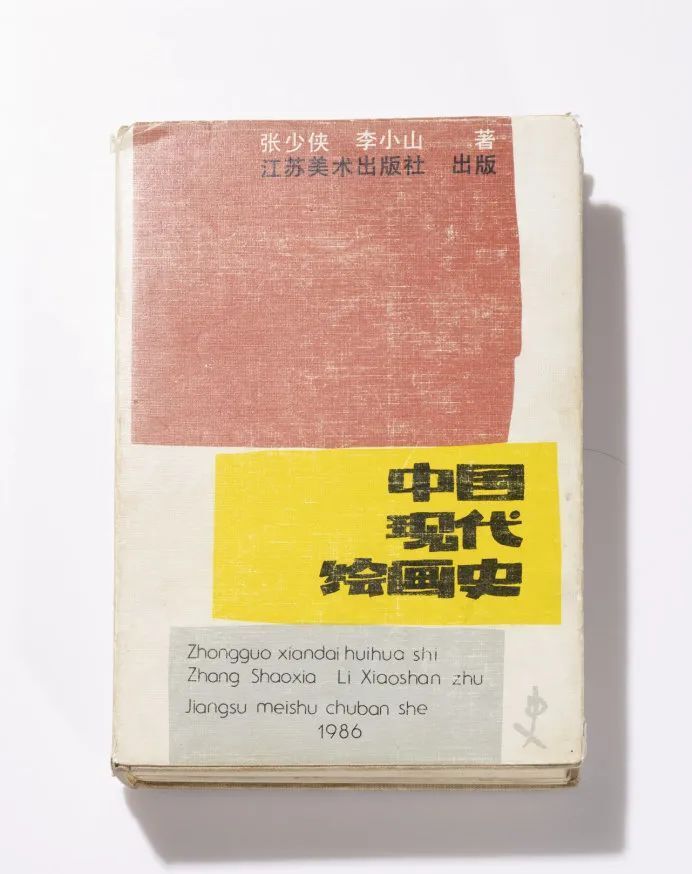
张少侠是聪明和能干兼而有之的人。他以一个美术史家、大学教授、海南大学艺术学院院长的身份进入商海,打拼多年,建树颇丰。现在,他回过头来,全力以赴画画,几年之内,竟有数百件作品的积累,着实令人咋舌——我得补充一句,画画对于他,自幼至今从未中断,而立志成为画家,在画画上大放异彩,则是他近几年的宏愿。我俩平时通电话,他不是在画室,就是去画室的路上。我在想,日复一日,月复一月,年复一年,几乎每天面对画布近10个小时,这样的韧劲,世上几人所能?其实,并不奇怪。早年他写书的时候,我已见识过,他是何等的勤奋:没日没夜,连续作战。按他自己的说法,做事要有做事的样子,要么不做,要做就得百分之百的投入。
张少侠主要治西方美术史,他对西方美术史上事件、人物、案例等如数家珍。他画油画,与他的学术兴趣相关。正如他年少时开始画“西画”,或多或少影响到他治西方美术史的学术兴趣一样。这里,我得指出,许多人喜欢引用的贡布里希关于“没有艺术,只有艺术家”的论断,从而强调艺术家个体创作的绝对性,我却是始终存疑的。艺术作为概念来说,是一个环环相扣的系统。不同时代的艺术家,只是延绵不绝的艺术系统里的某个角色——或许星光灿烂,或许微不足道。换句话说,艺术无论作为概念,还是作为实践,是先于个体而存在的。至于“人人都是艺术家”这样的艺术乌托邦,虽然鼓舞人心,但缺乏现实支撑。张少侠素来不是激进的人,他脚踏实地,坚决做自己能做的,不做自己想做的。能做和想做,一字之差,相距何止万---里?譬如,他在选择题材时,他遵循库尔贝“不画没见过的东西”这一法则。在选择画法时,又有如此坚守“传统”。依他的喜好,传统的、写实的方法已不在他的视野之内。然而,依他不急不躁、张弛有度的行事习惯,必须一步一步走得稳当而有效。
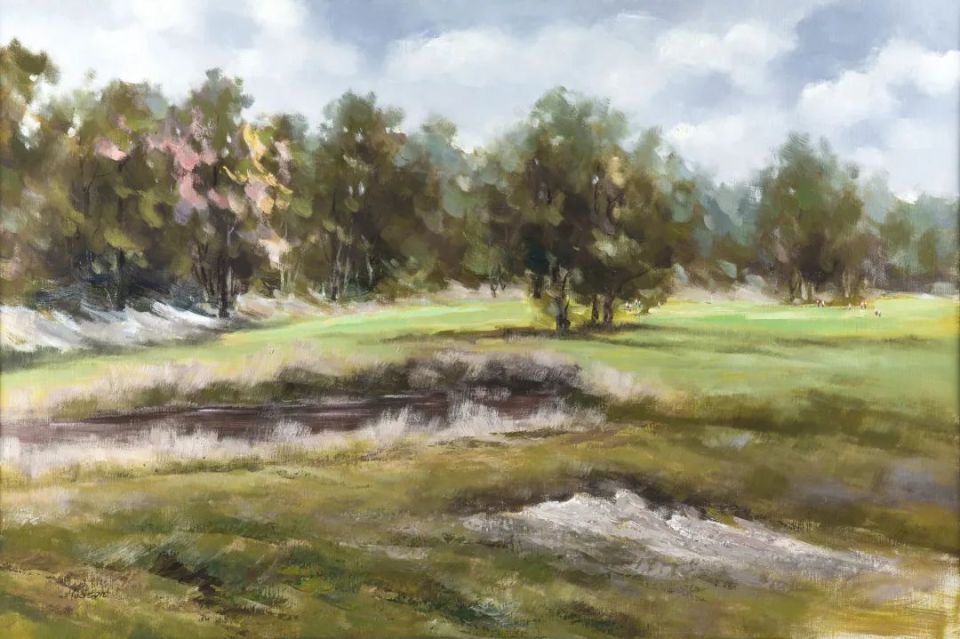
对于“绘画已死”的问题,我俩观点一致——无论从外部对绘画的期待,以及绘画内部的种种可能性,“绘画已死”是个伪命题。或者说,只是一些人故作惊人之语的偏见。200年前,雪莱为回击那些质疑诗是否有存在价值的言论,写下《为诗一辩》的名篇。200年过去,诗的现状如何,大家有目共睹。张少侠时常在欧美多国泡博物馆、美术馆。他非常清晰地了解艺术的过往和现状。作为传统视觉表达方式的绘画,不可避免地生出各种层次的臃肿和老化,犹如一个个矩阵,横堵在眼前——伟大的遗产亦是沉重的负担。许多艺术家普遍把当代艺术看做是“先进生产力”,他们奋力前行,采用各种方法和手段,将艺术粉碎、重组和翻新。他们成功了,历史的功劳簿上有他们重重一笔。但是,作为历史传承的一个部分,绘画终将如波德莱尔所说的,一半在变,一半永恒。
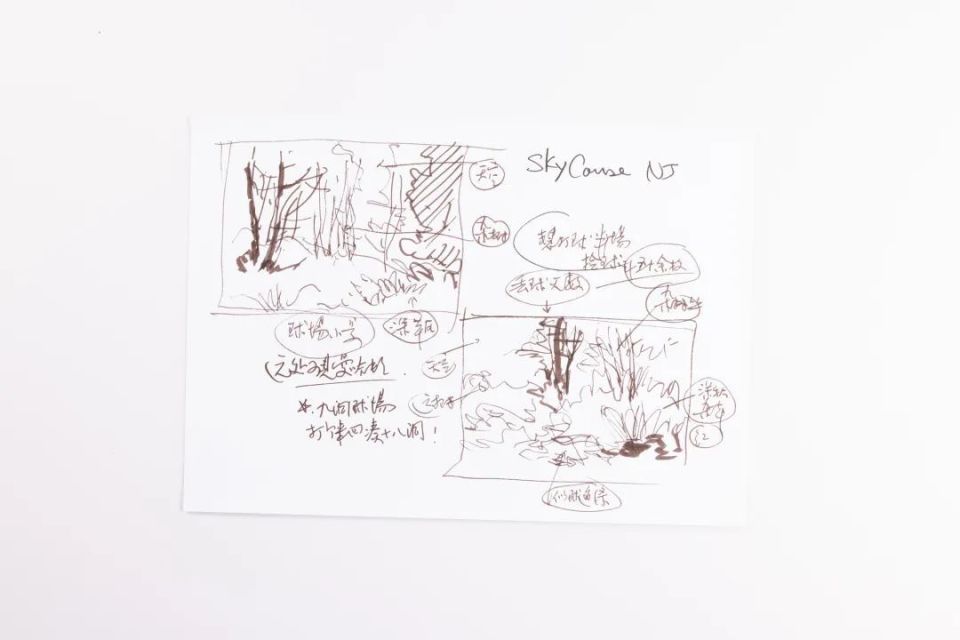
回到张少侠的绘画内部,看看他是如何只画“见过的东西”。是的,他属于单一题材的画家。单一到什么程度?他只画数十年来自己亲临过的、浸泡过无数汗水的高尔夫球场。那是他最熟悉的地方,也是十分热爱的地方。他几十幅、几百幅地描绘世界各地的高尔夫球场,情绪高涨,乐此不疲。画高尔夫球场与画风景大不同。天南地北的风景多姿多彩,而各地的高尔夫球场因其功能的要求,差异不大。大卫•霍格尼重画梵高画过的风景,由衷感叹:梵高画得“真像”。梵高也好,霍格尼也好,风景作为对象,终究是没有具体限定的。他们能够灌注大量情感,任意挥洒,自由拼接,所谓“一切景语皆情语”。张少侠着力画高尔夫球场,正如莫兰迪盯着瓶瓶罐罐,题材引导了观念,观念印证了画家选择题材的精准性。几年前,仅从他发给我的不那么清晰的图片看,我们之间关于他画作的交流或许还是一种客套。当我到他画室观看那么多的原作——蓦然发觉,他画画不单单是一时的兴趣。他有了新的目标。他要登高。他要创造他这个年龄段的奇迹。莫兰迪的瓶瓶罐罐是现代绘画拼图中不可或缺的一块。张少侠决意深耕高尔夫球场,以他的学识、天赋和勤勉,在这上面独领风骚,在我看来是可以提前预定的。
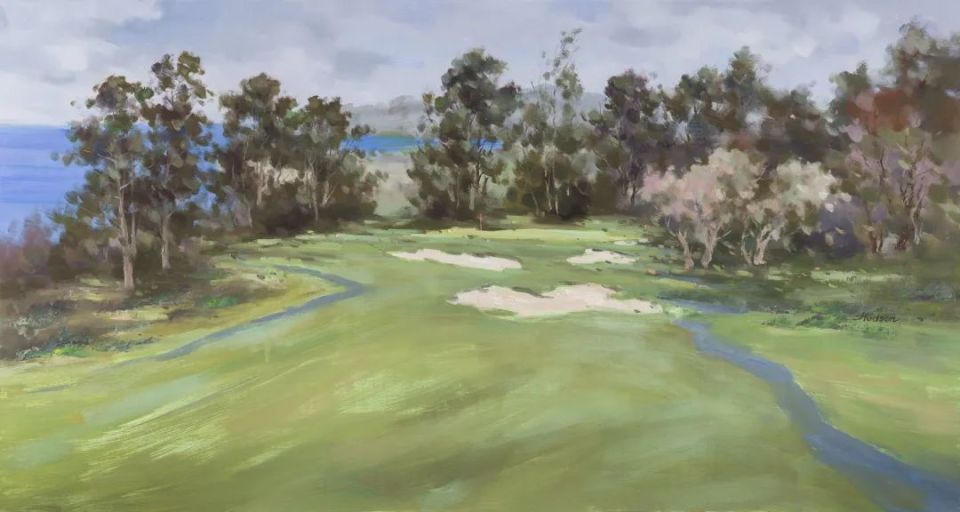
张少侠面对高尔夫球场这个特殊题材,采用的表现手法是否贴切?是否有更胜一筹的方式?他并不满意目前这种对他而言过于熟练的画法。用他的话说,不断重复以积聚力量,同时也有相当乏味的时候。他常常放下画笔,自我慎思,也会自我怀疑。我想起一句老生常谈:画什么不重要,怎么画才重要。实际上,对于创作者,绘画中所有现成的观念都是参照,没有对错的问题,只有个体如何选择的问题。毫无疑问,张少侠将遇到许多画家遇到过的普遍性焦虑——这样的焦虑可以是瓶颈,可以是转折。张少侠希望每幅画都能够对号入座,在相似中求不似,在不似中见真容,显然是对技法——构图、用笔、肌理、色彩等方面的严格检测。对象在不同季节里虽有变化,不过变化是表象性的。地貌构造没变,作者的角度及方位又是受限制的。所以,求变化无非靠画面的各种精妙处理。我想说,所谓画如其人,按在张少侠身上恰如其分。他眼界开阔,起点又高。在他的画作前,你分明看到画笔在他手里飞舞,快意十足——那是一种观赏的愉悦:帅气、洒脱、娴熟,外加漂亮。然而,他终究是缜密的人、理智的人。创作的奥秘往往是:理性的守门人越消极怠工,天赋的释放就越自然奔放。
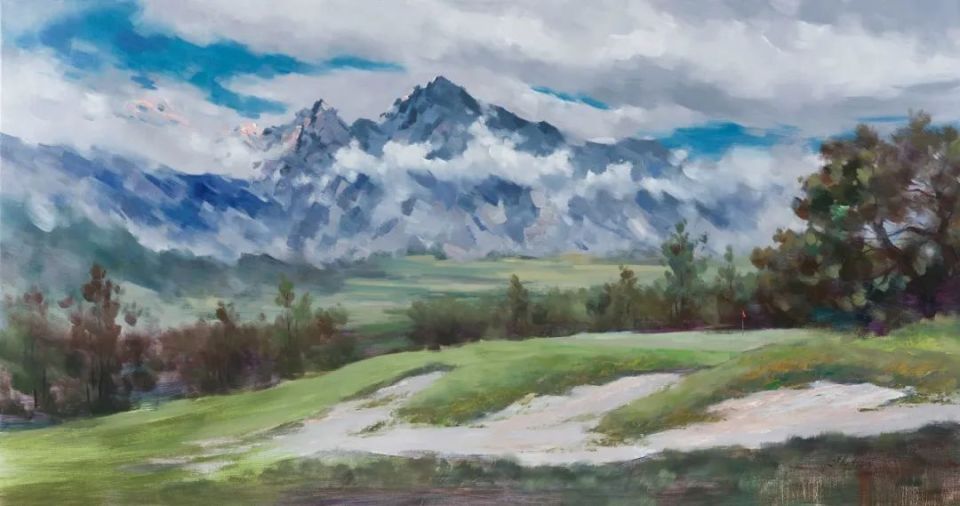
昆德拉有部作品名称:《生活在别处》。张少侠理想中的绘画也在别处。他脚踏实地,步步为营,不做跳跃某个阶段而直奔目标的事。若干时间过后,回头来看——我相信,他每个阶段,每个步骤,所作出的抉择都是诚实而正确的。
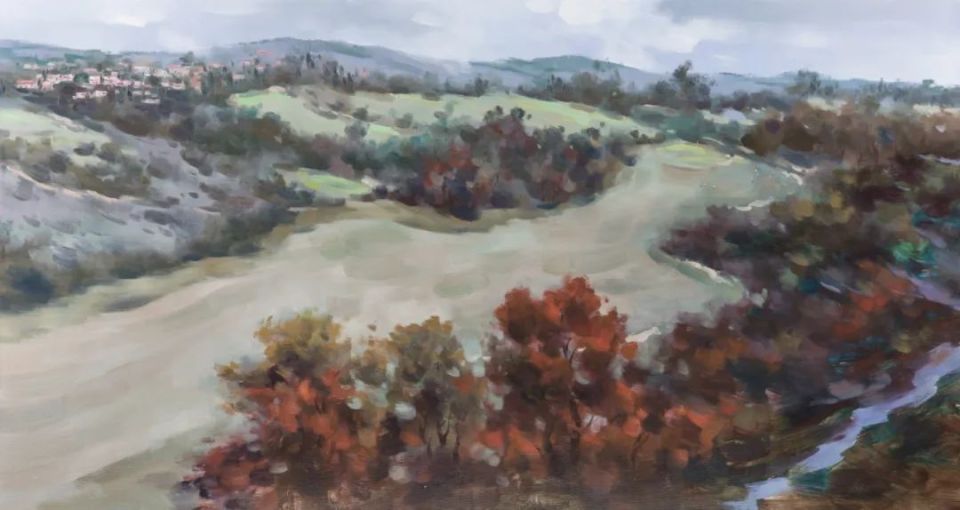
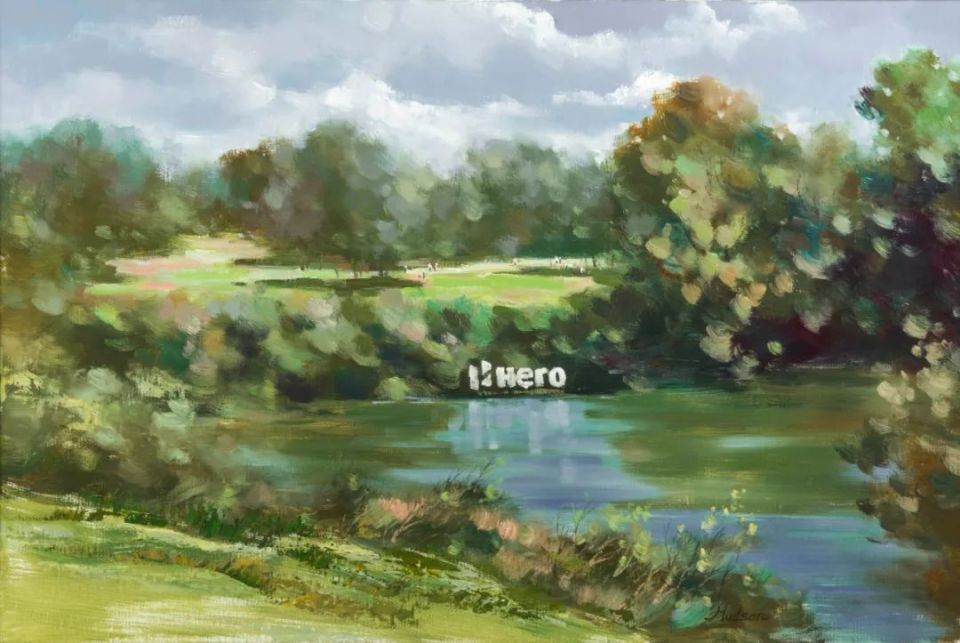
Preface
Li Xiaoshan
Director of Art Museum of Nanjing University of the Arts
In 1985, I was a graduate student, and it was during this time that I crossed paths with Hudson.Z, a promising young teacher at our esteemed Nanjing Arts Institute. Zhang had already begun to make waves in our institute with his unwavering dedication to the field. He was not just a mentor to me but also a trusted friend, offering invaluable guidance along my journey. It was during this period that I wrote a critical article on traditional Chinese painting, creating ripples within the art community. Zhang, with his characteristic boldness, proposed the idea of co-authoring a book - A History of Modern Chinese Painting. I readily embraced this proposition. By that time, Zhang had already authored books on the histories of arts and crafts spanning Europe, Asia, and Africa, and had also delved into Western art development. His remarkable accomplishments had led him to become the youngest associate professor at our institute, earning him the respect of his peers. Collaborating with him was an opportunity I could not afford to miss. During that period, we were inseparable, immersed in profound academic explorations, exchanging ideas, and occasionally finding ourselves in heated debates. I can confidently say that the joy of working together far surpassed the toils of the writing process. In 1987, Zhang made the decision to part ways with our institute and venture into new horizons in Hainan. From that point forward, his life’s narrative gained numerous captivating chapters. I recall a conversation we had during that period when he posed a question, “Is intelligence synonymous with capability?” Drawing from my experience, I responded, “They are two distinct qualities. An intelligent person may not necessarily be capable, and a capable person may not necessarily possess exceptional intelligence.”
Zhang embodies a rare blend of intelligence and capability. His journey has led him from the halls of academia, where he held titles such as art historian, professor, and Dean of the School of Arts at Hainan University, to the dynamic world of business. Throughout the years, he has achieved significant milestones. However, he has now returned to his true passion: painting. In just a few short years, he has created hundreds of artworks, a remarkable achievement that leaves one in awe. It’s worth noting that Zhang has never abandoned his love for painting, which he has nurtured since a young age. His current aspiration is to excel as a painter, a goal he wholeheartedly pursues. Our frequent telephone conversations have revealed that, when he’s not in his studio, he’s on his way there. I often wonder how one can face a canvas for nearly ten hours a day, day after day, month after month, year after year - such tenacity is truly remarkable. Yet, it doesn’t come as a surprise. In the early years when he was writing books, I had already witnessed his incredible diligence - working day and night. According to his own words, when you do something, you should do it properly. Either you don’t do it, or you give it your one hundred percent.
Zhang expertise lies in Western art history, and he possesses an in-depth knowledge of events, figures, and cases in Western art history. His interest in oil painting is closely connected to his academic pursuits. Starting to paint in a Western style at a young age, it was natural for his academic interests to gravitate towards Western art history. Here, I must emphasize that many are fond of quoting Gustave Courbet’s assertion that “it is not possible to have schools for painting; there are only painters,” underscoring the importance of individual creativity in art. However, I have always harbored reservations about this notion. Art, as a concept, is an intricately interconnected system. Artists from different eras are like components within this continuous system, each playing their role - some shining brightly, while others may remain less conspicuous. In other words, art exists independently of individual artists, both as a concept and as a practice. Regarding the utopian idea that “everyone is an artist,” while inspiring, it lacks a solid foundation in reality. Zhang has never been one to embrace radicalism; he remains grounded and adheres to what he can do, rather than pursuing lofty ideals. The distinction between “being able to do something” and “wanting to do something” is significant. For example, when selecting subjects for his paintings, he follows Courbet’s principle of not painting anything he hasn’t seen. When it came to choosing his painting style, he remains unwavering in this principle, even though, according to his preference, traditional and realistic methods are no longer within his scope. However, given his patient and measured approach, he had to proceed steadily and effectively, step by step.
When it comes to the notion that “painting is dead,” our views are in alignment. Whether we consider external expectations or the manifold possibilities within the realm of painting, the belief that “painting is dead” is but a fallacy. It is merely a provocative statement uttered by some. Two centuries ago, Percy Bysshe Shelley penned a famous essay titled A Defence of Poetry to counter those who questioned the value of poetry. Today, the state of poetry stands as evidence. Zhang often immerses himself in museums and art galleries across Europe and the United States, affording him a clear understanding of art’s past and present. As a traditional form of visual expression, painting inevitably gives rise to various levels of complexity and aging, much like matrices blocking the path - a great heritage that is also a heavy burden. Many artists view contemporary art as “advanced productive forces” and tirelessly strive to break new ground, using various methods and means to deconstruct, reassemble, and innovate. Their successes are well-documented, and their contributions are lauded in history. Nevertheless, painting, as part of our historical heritage, remains, as Charles Baudelaire aptly stated, “half changing and half eternal.”
Returning to Zhang’s approach to painting, it is essential to consider how he portrays what he has observed. Indeed, he is an artist dedicated to a singular subject. To what extent, you might wonder? He paints only the golf courses he has personally visited and where he has spent countless hours. These are places he knows intimately and cherishes deeply. He has captured the essence of golf courses from around the world, infusing his works with boundless enthusiasm and tireless dedication. Painting golf courses is a markedly different endeavor from painting landscapes. Landscapes from different regions are characterized by their diversity, while the function-driven nature of golf courses worldwide imposes certain limitations, resulting in less pronounced variations. David Hockney once revisited landscapes previously painted by Vincent van Gogh and marveled at how realistic van Gogh’s paintings were. Whether van Gogh or Hockney, landscapes, as a subject, are not confined to specific locations. Artists can infuse them with abundant emotions, allowing for free-form combinations, and expressing the sentiment. Hence, every landscape becomes a language of emotions. Zhang’s focus on golf courses is akin to Giorgio Morandi’s fixation on bottles and jars. The subject informs the concept, and the concept underscores the precision of the artist’s subject selection. Several years ago, based on the somewhat blurry images he sent me, our discussions about his artwork may have seemed somewhat formal. However, when I visited his studio and witnessed the multitude of original works, I suddenly realized that his dedication to painting was more than a passing interest. He had set a new goal for himself. He aspired to excel, even at his age. Morandi’s bottles and jars are an integral part of modern painting. Hudson.Z has resolved to immerse himself in the world of golf courses, and, with his knowledge, talent, and diligence, to shine in this field. In my estimation, this is an objective he is destined to achieve.
Is Zhang’s chosen painting style suitable for the unique subject of golf courses? Are there alternative approaches that might yield superior results? He is not entirely content with his current, highly proficient painting style. In his own words, the repetitive nature of his practice can accumulate strength but also bring periods of considerable tedium. Often, he sets his brush aside for introspection and self-doubt. This brings to mind the age-old adage: it’s not just what you paint those matters; how you paint it is equally important. For creators, all pre-existing concepts in painting serve as references; there is no right or wrong - only the question of how an individual chooses to approach it. Undoubtedly, Zhang faces the common anxiety experienced by many painters. Such anxiety can either act as a bottleneck or a turning point. Zhang hopes that each of his paintings can be distinctive. He strives to find uniqueness amid the similarities and truth amid the differences. This requires a rigorous examination of techniques - composition, brushwork, texture, and color, among others. While the subject may undergo changes with varying seasons, these changes are primarily superficial. The underlying topography remains constant, and the artist’s perspective and orientation are constrained. Therefore, achieving variety relies on the artist’s skill in subtly handling these elements. I must say that Zhang’s approach aligns perfectly with the idea that a painter’s style reflects their personality. He possesses a broad perspective and a solid foundation. When standing before his paintings, one can clearly see the brush dancing effortlessly in his hands, conveying a sense of enjoyment - handsome, carefree, skillful, and, of course, beautiful. However, he is a meticulous and rational individual. The mystery of creation often lies in how the gatekeeper of reason, when idle, allows the release of innate tal ent to flow naturally.
Milan Kundera once wrote a novel titled Life Is Elsewhere. Zhang’s idealized vision of painting resides in elsewhere as well. He proceeds methodically, step by step, without rushing toward a final destination. Reflecting upon this journey at a later time, I am confident that each stage, each step, and each choice he has made is both honest and correct.






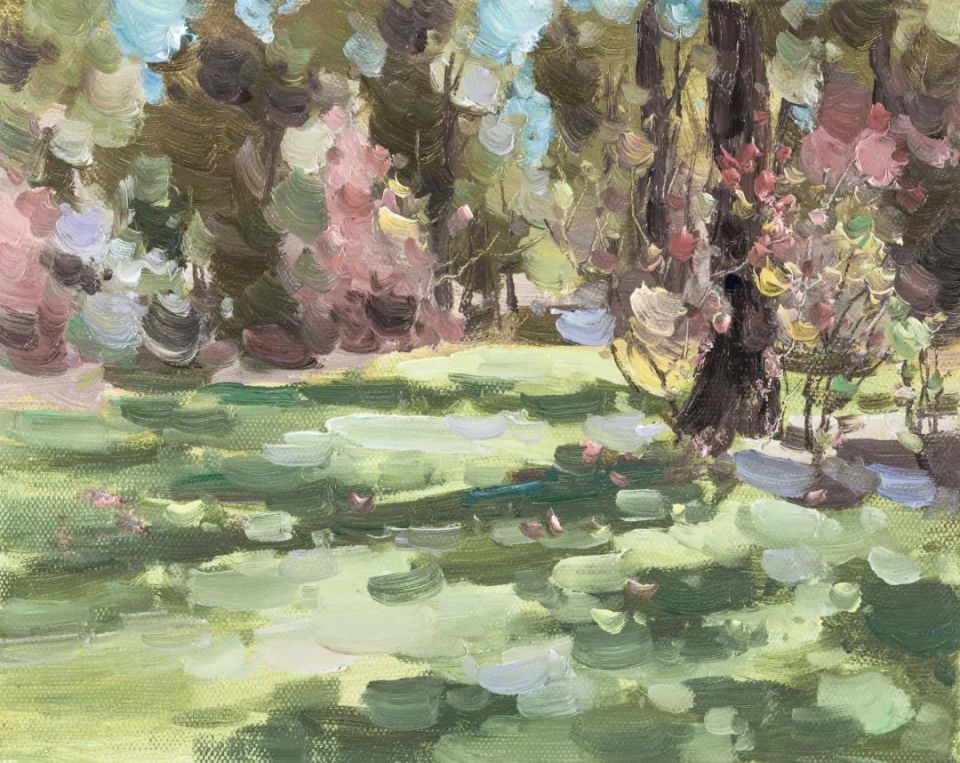






 京公网安备 11011302000792号粤ICP备17056390号-4信息网络传播视听节目许可证1909402号互联网域名注册证书中国互联网举报中心
京公网安备 11011302000792号粤ICP备17056390号-4信息网络传播视听节目许可证1909402号互联网域名注册证书中国互联网举报中心